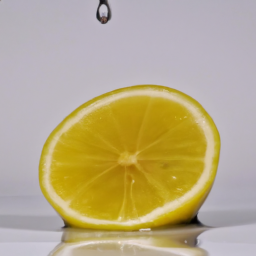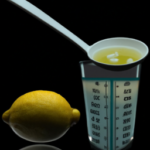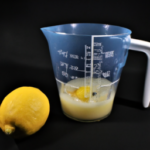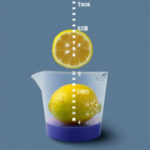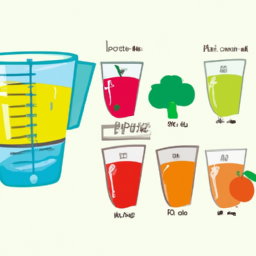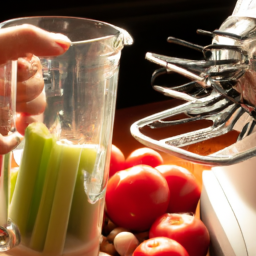I have always been curious about the amount of juice that can be extracted from a single lemon. As an enthusiast of cooking and baking, I often come across recipes that call for a specific amount of lemon juice. However, lemons vary in size and the amount of juice they produce can vary depending on various factors.
So, I decided to do some research and experimentation to find out just how much juice can be extracted from half a lemon. Through my research, I discovered that the amount of juice in half a lemon can vary widely, depending on the size and ripeness of the lemon, as well as how it is juiced.
While some lemons may yield just a few drops of juice, others can produce up to three tablespoons or more. Additionally, the amount of juice can also be affected by the temperature of the lemon and the pressure applied when juicing.
With so many variables to consider, it’s important to understand how to get the most juice out of your lemons, whether you’re making a refreshing glass of lemonade or adding a pop of flavor to your favorite dish.
Key Takeaways
- Lemon juice yield can vary based on factors like size, ripeness, temperature, and pressure applied when juicing.
- Hand-held citrus juicers or small manual presses can extract maximum juice, with a typical yield of about 2 tablespoons for a medium-sized lemon.
- Rolling the lemon on a hard surface before juicing, using a citrus reamer or juicer, and microwaving it before squeezing can help maximize yield.
- Adjusting the amount of lemon juice can control tartness of dish, and it is packed with nutrients like vitamin C, potassium, and folate.
Understanding the Variability of Lemon Juice
You might be surprised to learn that the amount of juice in a half lemon can vary greatly depending on factors such as the ripeness of the fruit and the amount of pressure applied when squeezing. These variability factors can affect the amount of acid content in the juice, which can have implications for cooking and baking.
For example, a ripe lemon with a thin skin will likely yield more juice than an unripe lemon with a thicker skin. Similarly, applying more pressure when squeezing the lemon can produce more juice, but it can also result in a higher concentration of bitter compounds.
It’s important to keep these factors in mind when using lemon juice in recipes, as the acidity can affect the overall flavor and texture of the dish. With this in mind, let’s explore how to measure the juice yield from half a lemon.
Measuring Juice Yield from Half a Lemon
When I measure juice yield from half a lemon, I typically use a hand-held citrus juicer or a small manual press. These tools help extract the maximum amount of juice from the lemon.
The typical yield for different lemon sizes can vary, but on average, a medium-sized lemon yields about 2 tablespoons of juice.
Tools for Measuring Juice
There’s no denying that having the right tools, like a citrus juicer, can make measuring the juice from half a lemon a breeze. Juice extraction can be a messy and frustrating process without the proper equipment.
Lemon squeezing techniques vary, but using a manual or electric citrus juicer is a reliable way to measure the juice from half a lemon with minimal effort. Manual citrus juicers work by applying pressure to the lemon half, forcing the juice out of the pulp and into a container. Electric juicers work similarly, but with the added convenience of motorized assistance. These tools not only make measuring juice yield more efficient, but they also prevent excess pulp and seeds from getting mixed in with the juice.
With these tools, measuring the juice from half a lemon has never been easier. When it comes to measuring the juice from half a lemon, the typical yield for different lemon sizes can vary. Understanding the amount of juice that can be extracted from a specific size of lemon is important for recipes that require precise measurements.
By using the right tools and knowing the typical yield for different lemon sizes, you can easily measure the juice from half a lemon and ensure your recipe turns out just right.
Typical Yield for Different Lemon Sizes
Knowing the typical yield for various sizes of lemons is crucial for achieving recipe precision and can be easily accomplished with the right tools. Lemon juice yields can vary greatly depending on the size of the lemon, with smaller lemons yielding less juice than larger ones. It’s important to keep in mind that the taste of the juice may also vary slightly due to differences in acidity levels between different types of lemons.
Here are some size comparisons to keep in mind when juicing lemons:
- Small lemons typically yield about 2 tablespoons of juice.
- Medium lemons typically yield about 3 tablespoons of juice.
- Large lemons typically yield about 4 tablespoons of juice.
When juicing lemons, there are a few techniques you can use to maximize the yield. Rolling the lemon on a hard surface before juicing can help break up the pulp and release more juice. Additionally, using a citrus reamer or juicer can help extract more juice from the lemon.
Understanding the typical yield for different sizes of lemons and utilizing these juicing techniques can help ensure you get the most juice possible for your recipes.
When it comes to getting the most juice out of your lemons, there are a few tips and tricks you can follow.
Tips for Getting the Most Juice Out of Your Lemons
Squeeze your lemons with a firm grip and twist to get the most juice out, just like you would wring out a wet towel. But, did you know that there are other ways to maximize the juice yield from your lemons?
Here are some tips to help you extract every last drop of juice from your lemons. First, roll your lemon on a hard surface, like a countertop, before cutting it open. This helps to break down the membranes inside the lemon and release the juice. You could also microwave your lemon for 10-15 seconds before squeezing it. This method warms up the fruit and makes it easier to extract the juice.
If you’re looking for creative recipes that use lemon juice but don’t have any lemons on hand, you can use substitutes such as vinegar or lime juice. However, keep in mind that these substitutes will change the flavor of your dish. With these tips, you’ll be able to get the most juice out of your lemons and use it in any recipe without worrying about running out.
Now that you know how to get the most juice out of your lemons, let’s talk about how to avoid bitterness in your lemon juice.
Avoiding Bitterness in Lemon Juice
To ensure your lemon juice is smooth and flavorful, you’ll want to take a few extra steps in preventing bitterness. Lemon juice can quickly become bitter if the white pith of the lemon is included in the juice. To avoid this, make sure to only juice the flesh of the lemon and leave the pith behind. Additionally, removing the seeds before juicing can also help prevent bitterness.
Another way to prevent bitterness is to use a pinch of salt. This may sound counterintuitive, but adding a small amount of salt to the lemon juice can actually enhance the flavor and balance out any bitterness. Lemon juice preservation is also important in preventing bitterness. To keep your lemon juice fresh, store it in an airtight container in the refrigerator for up to a week. Now that you know how to prevent bitterness in your lemon juice, let’s talk about storing leftover lemon juice.
Storing Leftover Lemon Juice
If you have some leftover lemon juice, you can easily store it in an airtight container in the fridge for up to a week. However, it’s important to store it properly to preserve its flavor. Here are three tips to help you make the most of your leftover lemon juice:
-
Use a glass container: Lemon juice can react with plastic or metal containers, affecting the taste and quality of the juice. Therefore, it’s best to store it in a glass container.
-
Cover the container tightly: Air exposure can cause the juice to spoil quickly, so make sure to cover the container tightly with a lid or plastic wrap.
-
Freeze it for longer storage: If you don’t plan to use the leftover lemon juice within a week, you can freeze it in ice cube trays. This way, you can easily use it in recipes later on without it going bad.
Preserving the flavor of leftover lemon juice is important, especially if you plan to use it in recipes.
In the next section, I’ll discuss some tips for using lemon juice in recipes.
Using Lemon Juice in Recipes
When I use lemon juice in recipes, I always keep in mind the common recipe measurements. For example, a tablespoon of lemon juice is usually equivalent to the juice of half a lemon.
However, I also adjust the amount of lemon juice according to my personal taste preference. It’s important to remember that while the recipe may call for a specific amount of lemon juice, it’s ultimately up to the individual to adjust the flavor to their liking.
Common Recipe Measurements
Hey, did you know that when it comes to using lemon juice in recipes, most measurements are standardized? Common recipe measurements include cups, tablespoons, and teaspoons. This makes it easy to follow recipes and achieve consistent results.
However, if you’re feeling creative and want to experiment with different lemon recipes, it’s good to know that there are substitutes for lemon juice that you can use, such as lime juice or vinegar.
When using lemon juice in recipes, it’s important to keep in mind that the amount of juice in one lemon can vary. On average, one medium-sized lemon will yield about 2-3 tablespoons of juice. However, the amount of juice can depend on factors such as the ripeness of the lemon and how you extract the juice.
If you prefer a stronger lemon flavor in your recipe, you can adjust the amount of lemon juice accordingly to your personal taste. This can be done by adding more or less lemon juice than the recipe calls for.
Adjusting for Personal Taste
In the previous subtopic, we discussed common recipe measurements, which are essential to know when following a recipe. However, recipes aren’t set in stone, and adjusting them to suit your personal taste is part of the fun of cooking.
Experimenting with ratio is a great way to adjust a recipe to your liking. When it comes to lemon juice, adjusting the ratio can help control the tartness of a dish. Some people prefer a more acidic taste, while others find it overpowering.
To adjust the tartness, try adding a little sugar or honey to the recipe to balance out the acidity. Alternatively, you can add more lemon juice if you prefer a tarter taste. It all comes down to personal preference, so don’t be afraid to experiment until you find the perfect ratio for your taste buds.
Overall, adjusting the ratio of lemon juice in a recipe is a fun way to experiment and create a dish that suits your taste.
Next, let’s dive into the health benefits of lemon juice and how it can improve our well-being.
Health Benefits of Lemon Juice
I’m excited to talk about the health benefits of lemon juice!
Did you know that lemon juice is packed with nutrients like vitamin C, potassium, and folate?
Not only that, but it has the potential to improve digestion, boost immunity, and even lower the risk of certain diseases.
Let’s explore the research and evidence behind these claims to see just how beneficial lemon juice can be for our health.
Nutritional Profile
Did you know that a half lemon contains essential vitamins such as vitamin C and potassium? Not only that, but it also has a significant amount of fiber and small amounts of other vitamins and minerals. The nutritional profile of lemons makes them a great addition to any diet.
Take a look at the table below to see the specific nutritional breakdown of a half lemon, including juice extraction, acid content, and other important nutrients:
| Nutrient | Amount per 1/2 Lemon |
|---|---|
| Calories | 6 |
| Carbohydrates | 2 grams |
| Fiber | 1 gram |
| Vitamin C | 30% of the daily value |
| Potassium | 1% of the daily value |
| Folate | 1% of the daily value |
| Calcium | 1% of the daily value |
These nutrients play a vital role in maintaining good health and can even provide potential health benefits. In the next section, we will explore these benefits in more detail.
Potential Health Benefits
Get ready to add some zing to your health routine – lemons pack a powerful punch of potential health benefits! Lemon juice is a great source of vitamin C, which is essential for maintaining a healthy immune system. It also contains antioxidants that can help protect your cells from damage caused by free radicals.
In addition, studies have shown that lemon juice may have potential weight loss benefits, as it can help increase feelings of fullness and reduce calorie intake. Recipes using lemon juice are a great way to incorporate this nutritious fruit into your diet. Lemon juice can be used in a variety of dishes, from savory to sweet.
For example, it can be used to make a tangy salad dressing, added to marinades for meat or fish, or used to flavor desserts like lemon bars or lemon meringue pie. And if you’re looking to shed a few pounds, try starting your day with a glass of warm lemon water to help boost your metabolism and aid in digestion.
Moving on to other uses for lemons, they can also be used for household cleaning and beauty treatments.
Other Uses for Lemons
Lemons are versatile fruits that can be used for more than just adding flavor to dishes. In fact, there are many non-culinary uses for lemons that make them a staple in many households. Here are just a few examples:
-
Lemons can be a great alternative to expensive and harsh cleaning chemicals. Mix lemon juice with water and vinegar to clean countertops, floors and windows. The acidity in lemons also makes them great for removing stains from clothing and fabrics.
-
Cut a lemon in half and leave it in a bowl in your kitchen or bathroom for a natural air freshener. You can also mix lemon juice with water and spray it around your home to eliminate odors.
-
Lemon juice can be used as a natural toner for your skin. It can also help to lighten dark spots and brighten your complexion. Just be careful not to use too much, as the acidity can be harsh on sensitive skin.
-
Lemon juice can be used to repel insects like ants and mosquitoes. Simply rub a lemon slice on your skin or leave lemon peels around your home to keep insects at bay.
-
The acidity in lemons can also help to remove rust from metal. Cut a lemon in half and rub it directly on the rusted area. Let it sit for a few hours before wiping it clean.
When it comes to using lemons, there are endless possibilities. But before you start using them, it’s important to choose the best lemons for your needs.
Choosing the Best Lemons
As someone who loves using lemons in cooking and baking, I’ve learned that it’s important to choose the best ones for optimal flavor and juice.
When selecting lemons, I consider their seasonal availability, looking for ones that are in season for the best flavor and texture.
I also look for signs of freshness and ripeness, such as a bright, glossy skin and a slightly soft texture when gently squeezed.
Seasonal Availability
You’re probably wondering what times of year you can expect to find fresh and juicy lemons for all your cooking and baking needs. As a virtual assistant, I’ve done some research and found out that lemons are seasonal fruits that are available all year round, but the peak season for lemons is from December to May in the Northern Hemisphere and from June to August in the Southern Hemisphere.
Here are some reasons why seasonal availability is important when it comes to using lemons for your recipes:
-
Better quality: When lemons are in season, they’re at their best quality and have a higher juice content, making them perfect for preserving. This means you’ll get more juice out of your lemons, resulting in more flavorful recipes.
-
Lower cost: When lemons are in season, they’re more abundant and therefore cheaper. This makes it more affordable to stock up on lemons for all your cooking and baking needs.
-
Sustainability: Buying seasonal produce helps support local farmers and reduces the environmental impact of transportation. It also ensures you’re consuming fresh and nutritious food.
With this information, you can plan ahead and purchase lemons during their peak season to ensure you’re getting the best quality and value.
Now, let’s move on to the next section where we’ll discuss how to identify the signs of freshness and ripeness in lemons.
Signs of Freshness and Ripeness
In the previous subtopic, we discussed the seasonal availability of lemons. Now, let’s talk about how to determine the freshness and ripeness of lemons.
As someone who loves to cook and bake, I understand the importance of using fresh and ripe ingredients, especially when it comes to lemons and their acidity levels.
One of the easiest ways to determine the freshness of a lemon is by looking at its skin. A fresh lemon will have a bright yellow color and a shiny, smooth skin. Any discoloration or wrinkles on the skin could indicate that the lemon is past its prime.
Another way to test freshness is by gently pressing the skin with your thumb. If the skin gives slightly, it means the lemon is ripe and juicy. However, if the skin is hard and doesn’t give at all, it could be a sign that the lemon is not as fresh.
Determining the acidity levels of a lemon is also important when it comes to cooking and baking. A lemon that is too ripe may have a lower acidity level, which could affect the overall flavor of your dish.
To test the acidity level, you can slice a small piece of the lemon and taste it. If the lemon is too sour, it may not be as ripe as it should be. However, if the lemon is too sweet, it could indicate that it’s overripe and may not have as much juice as you need.
By paying attention to these signs of freshness and ripeness, you can ensure that you’re getting the most out of your lemons when it comes to both flavor and juice.
Frequently Asked Questions
What is the nutritional value of lemon juice?
Did you know that lemon juice contains high levels of vitamin C, antioxidants and flavonoids? Consuming lemon juice can improve digestion, boost immunity, and promote healthy skin. Lemon juice can also be used as a natural exfoliant in skincare routines.
Can lemon juice be used for cleaning purposes?
Yes, lemon juice can be used as a natural disinfectant for cleaning purposes due to its acidic properties. It can be used to clean surfaces, remove stains, and eliminate odors. It’s an eco-friendly and affordable option for cleaning.
How long can lemon juice be stored in the refrigerator?
I store lemon juice in the fridge to preserve its nutrients and flavor. The shelf life is about 2-3 weeks at a fridge temperature of 40°F or below. I prefer storing it in glass bottles to maintain freshness.
Should I use a specific type of lemon for juicing?
When it comes to lemon juicing, I’ve found that using Meyer lemons yields the best results. They have a sweeter flavor and more juice than other varieties. Other lemon juicing tips include rolling the lemon before juicing and using a citrus juicer for maximum extraction.
Are there any potential side effects of consuming too much lemon juice?
Excessive lemon juice intake can cause dental erosion, heartburn, and gastrointestinal issues. It can also lead to dehydration due to its diuretic properties. Moderation is key to avoid potential health risks.
Conclusion
Overall, understanding the variability of lemon juice is important for getting the most out of your lemons. Measuring juice yield from half a lemon can help you determine how much juice you need for your recipes. Tips like rolling and microwaving your lemons can also help increase juice yield.
One interesting statistic is that lemons contain about 30-40% more juice when they’re at room temperature compared to when they’re cold from the refrigerator. This means that if you want to get the most juice out of your lemons, you should let them sit at room temperature for a bit before squeezing them.
By following these tips and tricks, you can get the most out of your lemons and enjoy their many health benefits.
Ilana has been a vegan for over 10 years. She originally made the switch for health reasons, but soon found herself becoming more and more passionate about the ethical and environmental implications of a vegan lifestyle. Ilana is the author of The Graceful Kitchen, a blog all about veganism. She loves to cook up delicious and nutritious vegan meals, and share her recipes with others who are interested in leading a cruelty-free life. Ilana is also a strong advocate for using whole foods as the foundation of a healthy diet, and believes that going vegan is one of the best ways to achieve this.
